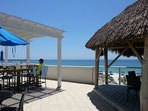
This post contains affiliate links, meaning Beachside Community Acupuncture PLLC may receive a small commission for purchases made through certain links at no additional cost to you. (In other words, you support us in a small way when you buy the products that we highly recommend and would use ourselves!) Click here to view our full disclosure policy.
Most of the organ systems in Traditional Chinese Medicine (TCM) share names with Western organs, even if they do not share the exact same functions. The one exception is the San Jiao (SJ), also called the Triple Burner, Triple Warmer, or Triple Energizer. While the other organs are a physical presence in Western medicine, the San Jiao's equivalent is the three body cavities - thoracic, abdominal, and pelvic - or the rough areas of the chest, the upper abdomen, and the lower abdomen.
A few fast facts about this abstract system:
- It is one of the six yang organs
- It is one of the twelve primary meridians
- It is included within the Fire element with its paired system, the Pericardium
This explanation probably doesn't mean much to you, so for the rest of this post we'll discuss how we use the San Jiao in the clinic.
Edema and Swelling
The San Jiao's chief job is to circulate different types of Qi (some of which are warming) and water, and each "burner" has a specific job based on the organ systems within it.
- The upper burner is like a fog that mists soft tissues like the skin, tendons, and muscles.
- The middle burner is like a cauldron because of its influence on digestion.
- The lower burner is like a drainage ditch as waste is separated and excreted.
If circulation through the burners is impaired, the body as a whole will not function well. Body Fluids in particular can back up and cause edema and swelling (among other things), so working on the San Jiao can be very beneficial for those conditions.
Issues with the Ear or Head
The San Jiao meridian starts at the ring finger, follows the arm up to the back of the shoulder, and then goes through the neck and around the ear to end at the face. While we can use this meridian for local issues in the arm and shoulder - or concerns in other parts of the body! - we especially love acupuncture point SJ10 for the ear and certain headaches.
"Stuck" Symptoms
The San Jiao and Gallbladder are related through the organ clock, but they also have a deeper connection. Picture a person standing tall with his arms by his side, thumbs facing forward. The Gallbladder meridian runs along the outside of the leg, and the San Jiao meridian runs along the outside of the arm. Without diving too deeply into TCM theory their similar location on the extremities makes them shaoyang meridians.
Shaoyang syndrome is characterized by alternating hot and cold flashes, but in essence it's a state of being stuck. For instance, if someone was sick and didn't fully recover afterward, TCM might say that the pathogen didn't make it inward but wasn't expelled either, leaving it to hang out in the body in a type of limbo.
We don't see this too often at the clinic, but for the few patients who have had shaoyang syndrome, using San Jiao and Gallbladder points had a very distinct impact on their symptoms.

Next Steps
If you'd like to work on the San Jiao at home, acupressure on the meridian and its points is a great place to start! You can search Google images to see its location, or if you want to be even more exact in your points, the book Atlas of Acupuncture is one of our favorites. Massaging acupoints with your fingers goes a long way, but you can also use ear seeds, a probe, or a variety of other tools to stimulate them. Otherwise we're more than happy to address San Jiao imbalances at our clinic.

Kathleen Ketola is a Licensed Acupuncturist and the owner of Beachside Community Acupuncture. She loves providing affordable acupuncture to the residents of McKinney, Texas, and surrounding cities like Prosper, Frisco, and Plano, but she also enjoys educating the general public on how acupuncture and Traditional Chinese Medicine (TCM) can treat everything from pain to infertility to stress and beyond. Click "Book Now" at the top of this page to book an appointment or feel free to contact her at (214) 417-2260.








